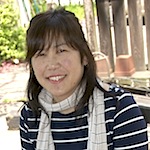A Project for Community Involvement
 The Japan Forum > Click Nippon > Creative Lesson Planning
The Japan Forum > Click Nippon > Creative Lesson Planning
A Project for Community Involvement
Inahara Kyoko
Japanese-language Teacher (High School, the American School in Japan)
2012.11.26
This is an update of the "Making a Difference" Project*.
It's a month into the project, and it's time for the students to give their presentation. Usually the day before presentations, I get emails such as "Sensei, I need more time to put everything together, can I get an extension?", but this time, I see that everyone has gathered in the classroom before class and is preparing. There are students looking through their notes reviewing their presentation content, some making last minute adjustments to their Powerpoint slides, and others checking the sound levels for their videos they intend to show. I wonder what their presentations will be like. It isn't only the students that are nervous, but I am as well. Perhaps it's just me, but I feel that the classroom has really come to life.
Through this project, the students will accomplish the following in Japanese. Also, it is understood that they must use as much as possible, vocabulary and grammar learned up to now.
The projects the students will take on are: "Tokyo's Garbage Problem", "Volunteer at Ishinomaki", "Ecology Promotion", "Homelessness", "Child Adoption Process", "Animal Protectionism", "Endangered Species", and "Cleaning up Shibuya." Of these, let me introduce "Volunteer at Ishinomaki."
3 female students registered through a community service group called Hands On Tokyo to volunteer at Ishinomaki, which was fishing town damaged by the earthquake and tsunami on March 11. They helped with such things as removing rocks one by one in fields and gardens, cleaning the harbors, and repairing boats. While volunteering, the students interviewed the local people about the earthquake and their hardships. The students were worried about whether it would be appropriate to ask such questions, but while they worked with the local people, it naturally came up in conversation.
In one of the videos, there is a cheerful elderly woman speaking to one of the students. The students are intensely listening carrying on a conversation. The fisherman's wife says, "We got this much fish!" The student replies, "Ahh, Really! Amazing! Sound delicious!" "Do you understand my accent?", asks the fisherman's wife. "Yes, I understand. daijobu desu", the student replies.
This group of students originally thought of interacting with children from an orphanage and visited one in Tokyo. However the one they contacted had various restrictions, and even with constant follow up things did not progress. As they were running out of time for the project, they reluctantly changed their topic. It turned out however that volunteering at Ishinomaki really opened their eyes. Although they experienced meeting some people reluctant to open up, they also experienced people of Ishinomaki, smiling in spite of facing such hard times which I think really changed their perspective of Japanese.
At the end of the project, I had them reflect and write what they thought. They all wrote that this was the most meaningful project of all the projects that they have done, and they were glad that did it. They also thought that the project should be offered from next year onwards as well. I was honestly surprised since they faced many difficulties in throughout the project - sometimes not agreeing on what to do, dealing with unfair allocation of work within the group, etc.
This is the power of the "real thing." Previous projects taught vocabulary and grammar through projects with certain themes or topics, and although the language taught is designed for actual situations they might encounter, it is different from the "real thing."
I would like to introduce some of the comments:
"The value of this project is that we use our Japanese outside of the classroom."
"Contacting the person was a bit hard since she often used words and kanjis I didn't recognize, but with the teacher's help, it was doable."
"Real life communication was used, such as phone calls and emails where you needed a quick yet correct response. This portrayed real Japanese, which was fun while difficult."
"I really liked this approach to learning and the project over anything we did before."
"I learned about my Japanese ability in real life situations, through numerous interviews, emails, and while handing out 40+ brochures. "
*"Making a Difference" Project:
Students come up with a theme that interest them, and think about how they can contribute to the theme. They take video footage of their activities and report on their purpose, what they did and what change they experienced.
 |
Inahara Kyoko |
|---|---|
| Japanese-language Teacher (High School, the American School in Japan) | |
Ms. Inahara grapples constantly with the questions of what skills students will need when they become adult members of society and how activities in Japanese-language class can develop those skills. Regarding her role as that of a facilitator, she incorporates a variety of activities into her lessons with the aim of bringing out the students’ latent abilities. |
Making Personal connections with Global Issues
Yoko Nishimura-Parke
A Project for Community Involvement
Inahara Kyoko